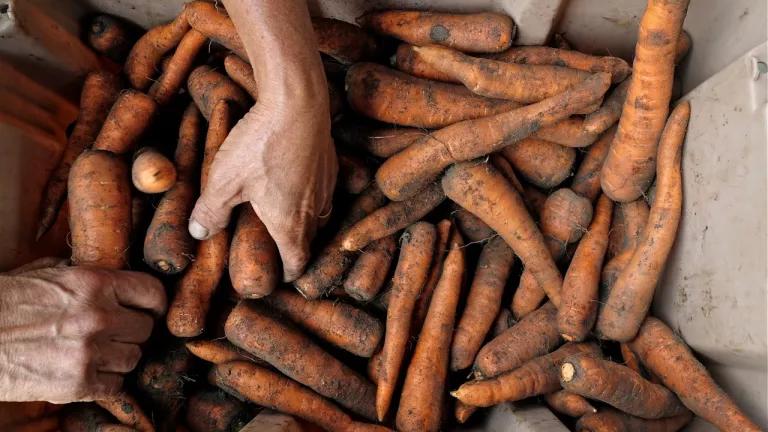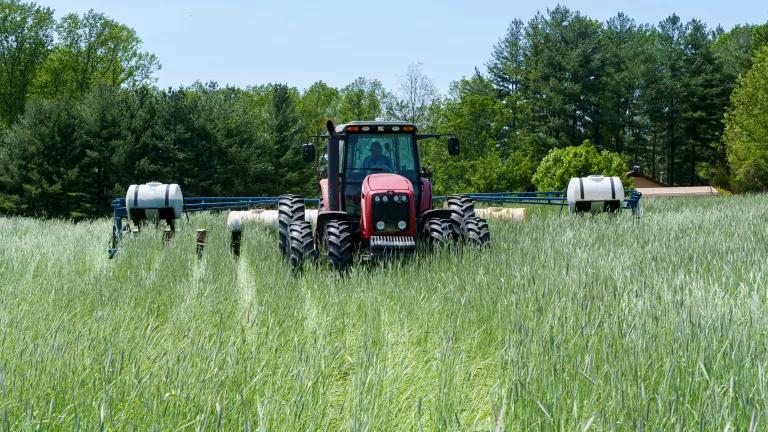Prevent Food Waste for Climate Week
Preventing food waste is the highest impact solution among Project Drawdown's solutions to keep temperature rise to 2°C by 2100. We need significant acceleration to reach the national goal to reduce food loss and waste by 50 percent by 2030.

About one-third of the world’s food goes uneaten, and when food is wasted, we squander land, water, and energy, and release carbon pollution in the process. Since 2015, the United States has had a national goal to reduce food waste by 50 percent by 2030—mirroring the U.N. sustainable development goal 12.3. Preventing food waste is the highest impact solution among Project Drawdown’s assessment of an array of solutions to keep temperature rise to 2°C by 2100. Reducing global food waste could avoid 88.5-102.2 gigatons of carbon dioxide equivalent emissions by 2050. The carbon pollution emissions from global food loss and waste are greater than all of the EU countries’ greenhouse gas emissions combined.
Composting rather than landfilling food scraps and other organic waste could avoid another gigaton of carbon pollution emissions. Shifting to plant-rich diets, conservation and regenerative agriculture, improved cattle feed and manure management, and more judicious use of fertilizers and irrigation have additional climate and resource preserving benefits. In order to drive climate action fast, we must fully implement the solutions available to us.
Many businesses, government agencies, and others are already working to address food waste—but we need significant acceleration to reach the national goal to reduce food loss and waste by 50% by 2030. For that reason, along with coalition partners, NRDC has released an action plan for the federal government to help reduce wasted food in the United States.
NRDC is calling on the Biden administration and Congress to take ambitious action through five key priorities articulated in the U.S. Food Waste Action Plan:
- Invest in food waste prevention and keep organic waste out of landfills and incinerators
- Enable donation of surplus food through financial incentives and food safety guidance
- Show leadership at home and abroad in our global commitments, government operations, and funding priorities
- Educate and activate households, the largest collective source of U.S. food waste
- Standardize food packaging date labels.
Furthermore, there are more than 20 opportunities for the 2023 Farm Bill to include actions that prevent food from becoming waste, rescue surplus food for redistribution, recycle food scraps into nutrient rich compost for soil amendment, and help draw down climate emissions. Because of their double- and triple-bottom line impacts, two of NRDC’s top priorities for addressing food waste are:
Solution A: Improve date labeling
Confusion over how to interpret the date printed on foods leads to a significant amount of consumer food waste—perhaps ten percent of all U.S. food waste. Because date labels are not federally regulated, states have a hodgepodge of rules that further confuse consumers and complicate inter-state commerce. Federal reform of food packaging date labels is a key solution to preventing food from becoming waste in our homes, grocery stores, and the emergency food system. Many people in the US mistakenly believe “expiration” dates mean food should be prematurely tossed when, in fact, they are used by manufacturers to communicate food’s peak freshness—not an indication of food safety. The only food item date that is federally regulated is infant formula, aimed at ensuring babies get adequate nutrition, which could decline in formula over time.
Congress must standardize food date labels into two discrete phrases, one which indicates quality (“best by”) and another for those few instances when there is an increased health and safety risk of food after the date on the label (“use by”). Regulating date labels must also come with a widespread and culturally appropriate initiative that will educate consumers about the meanings of the new phrases and the importance of using your senses to confirm that food is still good to eat, instead of relying on the printed date.
Lower-income households and those in food apartheid areas would especially benefit from improved regulation and education about the meaning of date labels because they most frequently must procure food from discount stores and food pantries which often stock food near the date on its label, meaning these households are more often faced with the decision as to whether to toss food past that date.
Impact: NRDC’s coalition partner ReFED estimates that if we standardized date labels and advanced public knowledge on how to interpret them, we could prevent 528,000 tons of food from being wasted in the U.S. Keeping that food out of landfills and incinerators would reduce 2.73 million metric tons of carbon dioxide equivalent greenhouse gas emissions. That is the same amount of carbon pollution produced by the yearly energy use of nearly 350,000 homes, or the equivalent benefit of running nearly 750 wind turbines. On top of that, there would be nearly $2.5 billion of net financial benefits, adding about $75 to every person’s wallet in the U.S.
Solution B: Invest in waste diversion
Though preventing food from becoming waste has greater benefits for climate, the economy and society, many of us initially think of composting food scraps when we think about food waste solutions. Recognizing that there will always be inedible food scraps to manage, like banana peels and eggshells, we advocate federal investment in infrastructure and planning for the measurement and recycling of organic waste material. Both composting and anaerobic digestion have the potential to recycle food waste into productive soil amendments.
In recent years, EPA and USDA have funded efforts to enhance composting and anaerobic digestion capacity. We need to continue to step up those investments, encourage applications of finished compost to soil (like on farms and in landscaping) to support circularity and end markets, and incentivize the planning and policy development (like organic waste bans) that support expanded food scrap recycling infrastructure. As waste infrastructure is expanded, we must ensure it does not perpetuate chronic overburdening of low-income, Black, Latino, and Tribal communities who often bear the brunt of waste pollution and nuisance.
Impact: Investing in food waste recycling could reduce almost six million metric tons of carbon dioxide equivalent greenhouse gas emissions, create 18,000 jobs and result in a net benefit of more than $220 million. Community composting, composting at a smaller scale such as in community gardens, has additional invaluable benefits to community resiliency, social inclusion, physical health, and environmental education.
While we celebrate Climate Week, we should keep in mind that addressing food waste offers an opportunity to simultaneously improve climate change, bolster community resiliency, and benefit the economy. No one likes to waste food. We can all get behind this sensible climate solution.




